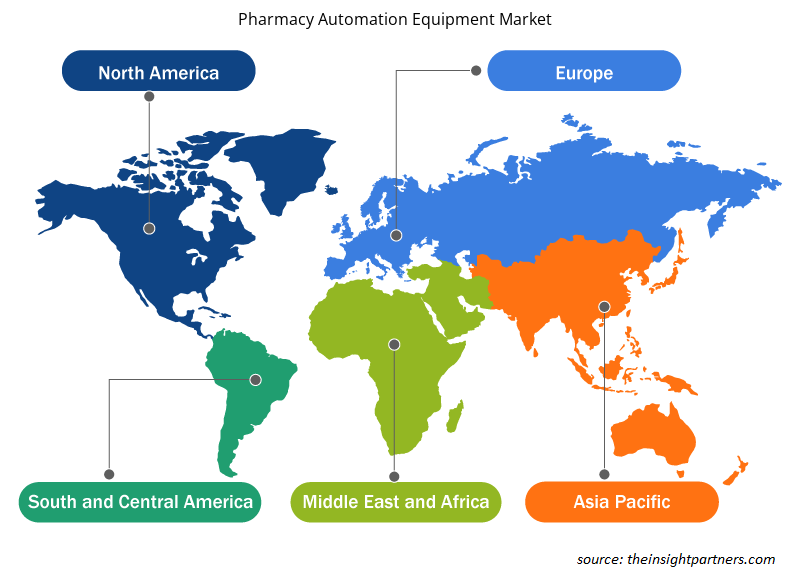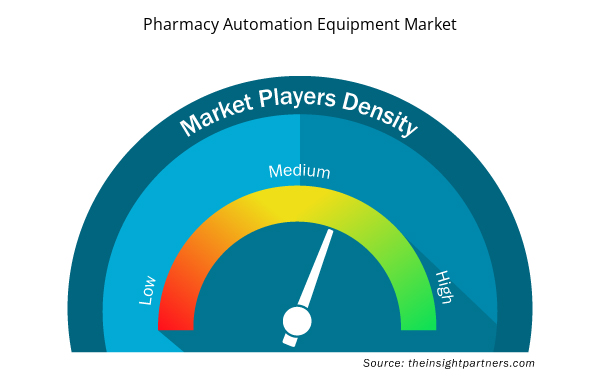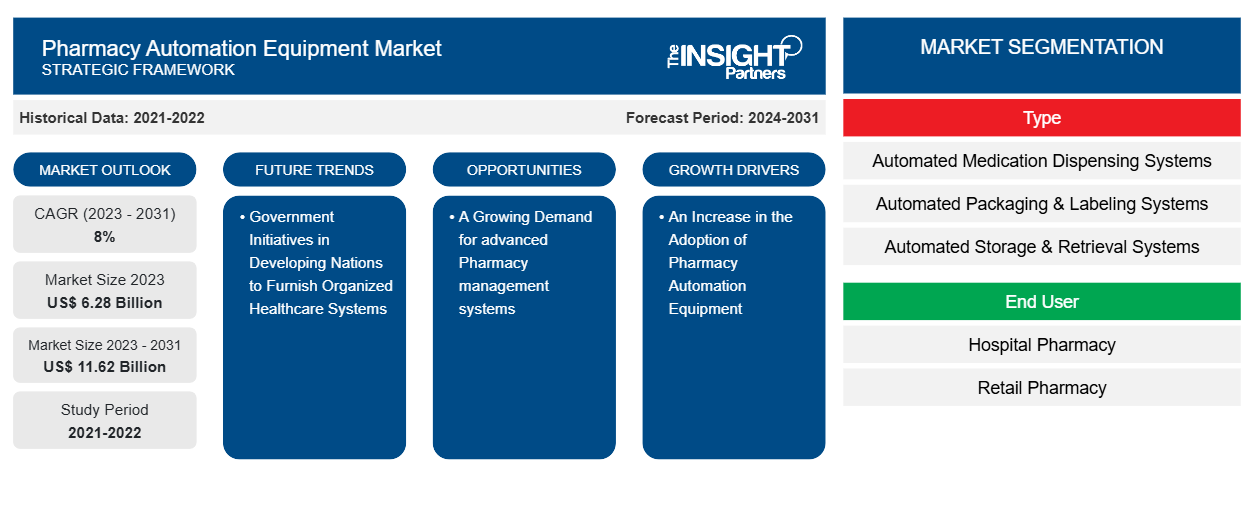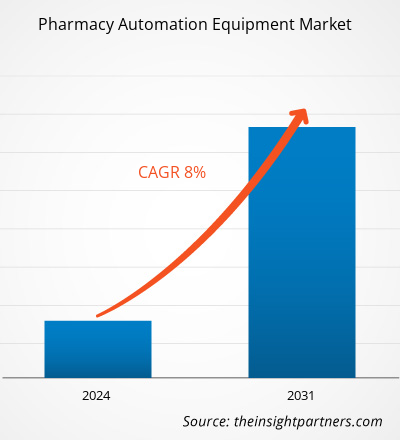Der Markt für Automatisierungsgeräte für Apotheken soll von 6,28 Milliarden US-Dollar im Jahr 2023 auf 11,62 Milliarden US-Dollar im Jahr 2031 anwachsen. Der Markt wird zwischen 2023 und 2031 voraussichtlich eine durchschnittliche jährliche Wachstumsrate (CAGR) von 8,00 % verzeichnen. Die Einführung von Medikamentenabgabesystemen, Robotern, künstlicher Intelligenz (KI), Telepharmazie und automatisierten Bestandsverwaltungssystemen dürfte ein wichtiger Trend auf dem Markt bleiben.
Marktanalyse für Apothekenautomatisierungsgeräte
Dank neuer Technologien verändert und verbessert sich der Gesundheitssektor ständig, insbesondere für Apotheken. Um Aktualität, Präzision und Genauigkeit zu gewährleisten, müssen Apotheken eine Vielzahl von Systemen verwenden. Daher müssen die in diesem Bereich tätigen Personen über technologische Fortschritte auf dem Laufenden bleiben. Vorreiter der technologischen Revolution zur Verbesserung der Patienten und Gesundheitsdienstleister war die Automatisierung der Apotheken. Dank der Automatisierung, die alles von mühsamen Aufgaben bis hin zum reibungslosen Austausch von Gesundheitsinformationen übernehmen kann, können Apotheker Patientenrezepte jetzt effizienter bearbeiten und produktiver arbeiten.
Marktübersicht für Apothekenautomatisierungsgeräte
Der Markt für Apothekenautomatisierungssysteme wird von den zahlreichen Vorteilen angetrieben, die sie Apotheken bieten. Die Automatisierung verbessert die Genauigkeit, den Apotheken-Workflow und das Patientenerlebnis und senkt gleichzeitig Kosten und medikamentenbezogene Fehler. Zukunftsprognosen für den globalen Automatisierungsmarkt deuten auf ein exponentielles Wachstum der Nachfrage nach Rezepten, der technischen Ausrüstung und der Erweiterung des technologischen Wissens hin. Der Bereich der digitalen Gesundheitsfürsorge wächst rasant und dominiert. Die Zahl der ausgestellten Rezepte wird parallel zur alternden Bevölkerung steigen, was bedeutet, dass die Automatisierung in Zukunft erhebliche Auswirkungen auf die Apothekenpraxis haben wird. Die Automatisierung kombiniert derzeit automatisierte Etikettierung, Verpackung, Lagerung und Abgabe, um Abgabefehler zu verringern und die Produktivität der Apothekenleiter zu steigern. Von diesem Punkt an wird das Unternehmen nur noch Elektronik und Technologie nutzen, um zu wachsen.
Passen Sie diesen Bericht Ihren Anforderungen an
Sie erhalten kostenlos individuelle Anpassungen an jedem Bericht, einschließlich Teilen dieses Berichts oder einer Analyse auf Länderebene, eines Excel-Datenpakets sowie tolle Angebote und Rabatte für Start-ups und Universitäten.
- Holen Sie sich die wichtigsten Markttrends aus diesem Bericht.Dieses KOSTENLOSE Beispiel umfasst eine Datenanalyse von Markttrends bis hin zu Schätzungen und Prognosen.
Treiber und Chancen auf dem Markt für Automatisierungsgeräte für Apotheken
Die zunehmende Einführung von Apothekenautomatisierungsgeräten begünstigt das Marktwachstum
Die Automatisierung von Apotheken erfolgt heute mithilfe von Robotik und KI. Mechanische Geräte, die als Apothekenroboter bezeichnet werden, können menschliches Verhalten nachahmen, wenn sie entsprechend programmiert sind, ohne dass ständige Unterstützung durch den Bediener erforderlich ist. Viele automatisierte Workflow-Systeme, Barcodes in Apotheken und Systeme zur Medikamentenausgabe werden beispielsweise als Robotersysteme eingestuft. Künstliche Intelligenz (KI) ist ein sich rasch entwickelndes Feld in der Apothekentechnologie, das für verschiedene Aufgaben wie Polypharmakologie, Darreichungsformdesign, Arzneimittelentdeckung, Computerprogramme und Krankenhausapotheke eingesetzt werden kann. Da KI typischerweise verwendet wird, um menschliche kognitive Aufgaben nachzuahmen, könnte die Pharmaindustrie einen deutlichen Anstieg bei der Verwendung dieser Technologie erleben. Sie kann verwendet werden, um menschenähnliche Aufgaben auf digitalen Computern oder computergesteuerten Robotern (wie z. B. automatisierten Ausgabeschränken) auszuführen. Führende Pharmaunternehmen beginnen, künstliche Intelligenz (KI) in Forschung und Entwicklung, Arzneimittelentdeckung, Gesundheitssystemanalyse, Medikamentengenauigkeit, medizinischer Unterstützung und Betreuung einzusetzen, und helfen bei sich wiederholenden Aufgaben, der Gestaltung von Behandlungsplänen und der Pflege von Krankenakten. KI kann in Krankenhausapotheken für eine Vielzahl von Zwecken eingesetzt werden, darunter Barcode-Scanning, automatisierte Medikamentenzubereitung, automatisierte Nachverfolgung und Abgabe. Daher dürfte eine zunehmende Nutzung in Verbindung mit neuen Anwendungen von Apothekenautomatisierungssystemen das Wachstum des Marktes vorantreiben.barcoding, and medication dispensing systems are all categorized as robotic. Artificial Intelligence (AI) is a rapidly developing field in pharmacy technology that can be applied to various tasks like polypharmacology, dosage form design, drug discovery, computer programs, and hospital pharmacy. Since AI is typically used to mimic human cognitive tasks, the pharmaceutical industry may see a significant increase in its use of this technology. It can be used to carry out human-like tasks on digital computers or computer-controlled robots (such as automated dispensing cabinets). Leading pharmaceutical companies are beginning to use artificial intelligence (AI) in research and development, drug discovery, healthcare system analysis, medication accuracy, medical support, and assistance, helping with repetitive tasks, treatment plan design, and health record maintenance. AI can be used in hospital pharmacies for a variety of purposes, including barcode scanning, automated medication preparation, automated tracking, and dispensing. Thus, an increase in use coupled with emerging applications of pharmacy automation systems is likely to drive the growth of the market.
Regierungsinitiativen in Entwicklungsländern
Da die Gesundheitskosten steigen und der Druck zunimmt, den Zugang zu Dienstleistungen zu verbessern, spielt das Arzneimittelmanagement in Entwicklungsländern eine entscheidende Rolle. So hat sich beispielsweise die Rolle des Apothekers erweitert und umfasst nun auch die Gewährleistung angemessener Beratung , Überwachung und Einhaltung der Medikamenteneinnahme sowie die Verhinderung der Entwicklung einer HIV-Arzneimittelresistenz in vielen ressourcenbeschränkten, vom Virus belasteten Umgebungen. Dies führt zu einem Bedarf an hochmodernen technologischen Lösungen. Die Regierungen der Entwicklungsländer ergreifen verschiedene Maßnahmen, um den Zugang zu diesen Medikamenten zu erleichtern. Um beispielsweise die Bereitstellung von HIV-Behandlungen zu verbessern, hat das Ministerium für Gesundheit und Soziales in Namibia eine mehrmonatige Abgabe eingeführt, um die Ausweitung der antiretroviralen Therapie zu ermöglichen. In Namibias Gesundheitseinrichtungen wird dies derzeit weithin genutzt, was dazu beiträgt, die HIV-Behandlungsziele des Landes zu erreichen. In Indien macht der Krankenhaussektor 80 % des gesamten Gesundheitsmarktes aus. Es besteht eine erhebliche Nachfrage sowohl von inländischen als auch von internationalen Investoren. Folglich werden diese Faktoren im Prognosezeitraum wahrscheinlich erhebliche Wachstumschancen für den Markt für Apothekenautomatisierungsgeräte schaffen.antiretroviral therapy. In Namibia's healthcare facilities, this is currently widely used, which aids in achieving the country's HIV treatment objectives. In India, the hospital sector makes up 80% of the whole healthcare market. There is a significant demand for it from both domestic and international investors. Consequently, during the projected period, these factors are probably going to generate significant growth opportunities for the pharmacy automation equipment market.
Marktbericht zur Automatisierungsausrüstung für Apotheken – Segmentierungsanalyse
Schlüsselsegmente, die zur Ableitung der Marktanalyse für Apothekenautomatisierungsgeräte beigetragen haben, sind Typ und Endbenutzer.
- Nach Typ ist der Markt für Apothekenautomatisierungsgeräte in automatisierte Medikamentenabgabesysteme, automatisierte Verpackungs- und Etikettiersysteme, automatisierte Lager- und Bereitstellungssysteme, automatisierte Mischgeräte und Tischtablettenzähler unterteilt. Das Segment der automatisierten Medikamentenabgabesysteme hatte im Jahr 2023 den größten Marktanteil.
- Nach Endverbraucher ist der Markt in Krankenhausapotheken, Einzelhandelsapotheken und andere segmentiert. Das Segment der Krankenhausapotheken hatte im Jahr 2023 den größten Marktanteil.
Marktanteilsanalyse für Apothekenautomatisierungsgeräte nach Geografie
Der geografische Umfang des Marktberichts für Apothekenautomatisierungsgeräte ist hauptsächlich in fünf Regionen unterteilt: Nordamerika, Asien-Pazifik, Europa, Naher Osten und Afrika sowie Süd- und Mittelamerika.
Nordamerika hat den größten Anteil des globalen Marktes erobert. Das Wachstum wird von Faktoren wie der zunehmenden Nutzung von Apothekenautomatisierungsgeräten in den USA, dem wachsenden Gesundheitsbewusstsein der Bevölkerung, zunehmenden Regierungsinitiativen und der Präsenz führender Akteure vorangetrieben. Ein wichtiger Treiber des Marktwachstums ist die Zunahme von Medikationsfehlern und die steigende Nachfrage nach pharmazeutischen Produkten. Die wachsende Patientenzahl in den USA weist auf eine Zunahme der Zahl der Patienten hin, die täglich mehrere Medikamente einnehmen. Untersuchungen zeigen, dass in den USA über 50 % der Patienten mindestens ein Rezept haben und viele davon täglich mehrere Medikamente einnehmen, was sie einem erhöhten Risiko von Medikationsfehlern und potenziellen Gesundheitsrisiken aussetzt. Die steigende Nachfrage nach pharmazeutischen Produkten, die fortschreitende Technologie und der Bedarf an präzisen Robotergeräten und -werkzeugen zur effizienten Ausführung von Aufgaben werden voraussichtlich Schlüsselfaktoren für das Marktwachstum sein.
Regionale Einblicke in den Markt für Apothekenautomatisierungsgeräte
Die regionalen Trends und Faktoren, die den Markt für Apothekenautomatisierungsgeräte während des gesamten Prognosezeitraums beeinflussen, wurden von den Analysten von Insight Partners ausführlich erläutert. In diesem Abschnitt werden auch die Marktsegmente und die Geografie von Apothekenautomatisierungsgeräten in Nordamerika, Europa, im asiatisch-pazifischen Raum, im Nahen Osten und Afrika sowie in Süd- und Mittelamerika erörtert.

- Erhalten Sie regionale Daten zum Markt für Apothekenautomatisierungsgeräte
Umfang des Marktberichts über Automatisierungsgeräte für Apotheken
| Berichtsattribut | Details |
|---|---|
| Marktgröße im Jahr 2023 | 6,28 Milliarden US-Dollar |
| Marktgröße bis 2031 | 11,62 Milliarden US-Dollar |
| Globale CAGR (2023 - 2031) | 8 % |
| Historische Daten | 2021-2022 |
| Prognosezeitraum | 2024–2031 |
| Abgedeckte Segmente | Nach Typ
|
| Abgedeckte Regionen und Länder | Nordamerika
|
| Marktführer und wichtige Unternehmensprofile |
|
Dichte der Marktteilnehmer für Apothekenautomatisierungsgeräte: Die Auswirkungen auf die Geschäftsdynamik verstehen
Der Markt für Automatisierungsgeräte für Apotheken wächst rasant. Dies wird durch die steigende Nachfrage der Endnutzer aufgrund von Faktoren wie sich entwickelnden Verbraucherpräferenzen, technologischen Fortschritten und einem größeren Bewusstsein für die Vorteile des Produkts vorangetrieben. Mit der steigenden Nachfrage erweitern Unternehmen ihr Angebot, entwickeln Innovationen, um die Bedürfnisse der Verbraucher zu erfüllen, und nutzen neue Trends, was das Marktwachstum weiter ankurbelt.
Die Marktteilnehmerdichte bezieht sich auf die Verteilung der Firmen oder Unternehmen, die in einem bestimmten Markt oder einer bestimmten Branche tätig sind. Sie gibt an, wie viele Wettbewerber (Marktteilnehmer) in einem bestimmten Marktraum im Verhältnis zu seiner Größe oder seinem gesamten Marktwert präsent sind.
Die wichtigsten Unternehmen auf dem Markt für Automatisierungsgeräte für Apotheken sind:
- Cerner Corporation
- AmerisourceBergen
- Baxter International Inc
- Talyst LLC (Swisslog Healthcare)
- Capsa-Gesundheitswesen
- BD
Haftungsausschluss : Die oben aufgeführten Unternehmen sind nicht in einer bestimmten Reihenfolge aufgeführt.

- Überblick über die wichtigsten Akteure auf dem Markt für Apothekenautomatisierungsgeräte
Neuigkeiten und aktuelle Entwicklungen zum Markt für Automatisierungsgeräte für Apotheken
Der Markt für Apothekenautomatisierungsgeräte wird durch die Erhebung qualitativer und quantitativer Daten nach Primär- und Sekundärforschung bewertet, die wichtige Unternehmensveröffentlichungen, Verbandsdaten und Datenbanken umfasst. Nachfolgend sind einige der Entwicklungen auf dem Markt für Apothekenautomatisierungsgeräte aufgeführt:
- BD (Becton, Dickinson and Company), ein weltweit führendes Medizintechnikunternehmen, und Frazier Healthcare Partners, ein führendes Private-Equity-Unternehmen, das sich ausschließlich auf den Gesundheitssektor konzentriert, haben eine endgültige Vereinbarung bekannt gegeben, wonach BD Parata Systems, einen innovativen Anbieter von Apothekenautomatisierungslösungen, für 1,525 Milliarden US-Dollar übernimmt. (Quelle: BD, Pressemitteilung, Juni 2022)
- Kanadische Apotheken, die den Krankenhaus-, Einzelhandels- und Langzeitpflegemarkt bedienen, haben jetzt Zugang zu Apothekenautomatisierungstechnologie der nächsten Generation, um die Zuverlässigkeit, Effizienz und Sicherheit der Medikamentenverwaltung zu erhöhen. Dazu gehören Verpackungs- und Inspektionssysteme für Haftbeutel sowie halbautomatische Frontlader-Fläschchenabfüllmaschinen. (Quelle: News Letter, April 2024)
Marktbericht zu Automatisierungsgeräten für Apotheken – Umfang und Ergebnisse
Der Bericht „Marktgröße und Prognose für Apothekenautomatisierungsgeräte (2021–2031)“ bietet eine detaillierte Analyse des Marktes, die die folgenden Bereiche abdeckt:
- Marktgröße und Prognose für Apothekenautomatisierungsgeräte auf globaler, regionaler und Länderebene für alle wichtigen Marktsegmente, die im Rahmen des Berichts abgedeckt sind
- Markttrends und Marktdynamiken für Apothekenautomatisierungsgeräte wie Treiber, Einschränkungen und wichtige Chancen
- Detaillierte PEST/Porters Five Forces- und SWOT-Analyse
- Analyse des Marktes für Automatisierungsgeräte für Apotheken, die wichtige Markttrends, globale und regionale Rahmenbedingungen, wichtige Akteure, Vorschriften und aktuelle Marktentwicklungen umfasst.
- Branchenlandschaft und Wettbewerbsanalyse, die die Marktkonzentration, Heatmap-Analyse, prominente Akteure und aktuelle Entwicklungen auf dem Markt für Apothekenautomatisierungsgeräte umfasst
- Detaillierte Firmenprofile
- Historische Analyse (2 Jahre), Basisjahr, Prognose (7 Jahre) mit CAGR
- PEST- und SWOT-Analyse
- Marktgröße Wert/Volumen – Global, Regional, Land
- Branche und Wettbewerbsumfeld
- Excel-Datensatz



Report Coverage
Revenue forecast, Company Analysis, Industry landscape, Growth factors, and Trends

Segment Covered
This text is related
to segments covered.

Regional Scope
North America, Europe, Asia Pacific, Middle East & Africa, South & Central America

Country Scope
This text is related
to country scope.
Häufig gestellte Fragen
North America dominated the pharmacy automation equipment market in 2023
Key factors driving the market are an increase in the adoption of pharmacy automation equipment and a growing demand for pharmacy automation equipment.
The emergence of medication dispensing systems, robotics, artificial intelligence (AI), telepharmacies, and automated inventory management systems are likely to remain a key trend in the market.
Cerner Corporation, AmerisourceBergen, Baxter International Inc, Talyst LLC (Swisslog Healthcare), Capsa Healthcare, BD, OMNICELL INC, MCKESSON CORPORATION, ScriptPro LLC, YUYAMA Co., Ltd
The market is expected to register a CAGR of 8.0% during 2023–2031.
Trends and growth analysis reports related to Life Sciences : READ MORE..
The Insight Partners performs research in 4 major stages: Data Collection & Secondary Research, Primary Research, Data Analysis and Data Triangulation & Final Review.
- Data Collection and Secondary Research:
As a market research and consulting firm operating from a decade, we have published and advised several client across the globe. First step for any study will start with an assessment of currently available data and insights from existing reports. Further, historical and current market information is collected from Investor Presentations, Annual Reports, SEC Filings, etc., and other information related to company’s performance and market positioning are gathered from Paid Databases (Factiva, Hoovers, and Reuters) and various other publications available in public domain.
Several associations trade associates, technical forums, institutes, societies and organization are accessed to gain technical as well as market related insights through their publications such as research papers, blogs and press releases related to the studies are referred to get cues about the market. Further, white papers, journals, magazines, and other news articles published in last 3 years are scrutinized and analyzed to understand the current market trends.
- Primary Research:
The primarily interview analysis comprise of data obtained from industry participants interview and answers to survey questions gathered by in-house primary team.
For primary research, interviews are conducted with industry experts/CEOs/Marketing Managers/VPs/Subject Matter Experts from both demand and supply side to get a 360-degree view of the market. The primary team conducts several interviews based on the complexity of the markets to understand the various market trends and dynamics which makes research more credible and precise.
A typical research interview fulfils the following functions:
- Provides first-hand information on the market size, market trends, growth trends, competitive landscape, and outlook
- Validates and strengthens in-house secondary research findings
- Develops the analysis team’s expertise and market understanding
Primary research involves email interactions and telephone interviews for each market, category, segment, and sub-segment across geographies. The participants who typically take part in such a process include, but are not limited to:
- Industry participants: VPs, business development managers, market intelligence managers and national sales managers
- Outside experts: Valuation experts, research analysts and key opinion leaders specializing in the electronics and semiconductor industry.
Below is the breakup of our primary respondents by company, designation, and region:

Once we receive the confirmation from primary research sources or primary respondents, we finalize the base year market estimation and forecast the data as per the macroeconomic and microeconomic factors assessed during data collection.
- Data Analysis:
Once data is validated through both secondary as well as primary respondents, we finalize the market estimations by hypothesis formulation and factor analysis at regional and country level.
- Macro-Economic Factor Analysis:
We analyse macroeconomic indicators such the gross domestic product (GDP), increase in the demand for goods and services across industries, technological advancement, regional economic growth, governmental policies, the influence of COVID-19, PEST analysis, and other aspects. This analysis aids in setting benchmarks for various nations/regions and approximating market splits. Additionally, the general trend of the aforementioned components aid in determining the market's development possibilities.
- Country Level Data:
Various factors that are especially aligned to the country are taken into account to determine the market size for a certain area and country, including the presence of vendors, such as headquarters and offices, the country's GDP, demand patterns, and industry growth. To comprehend the market dynamics for the nation, a number of growth variables, inhibitors, application areas, and current market trends are researched. The aforementioned elements aid in determining the country's overall market's growth potential.
- Company Profile:
The “Table of Contents” is formulated by listing and analyzing more than 25 - 30 companies operating in the market ecosystem across geographies. However, we profile only 10 companies as a standard practice in our syndicate reports. These 10 companies comprise leading, emerging, and regional players. Nonetheless, our analysis is not restricted to the 10 listed companies, we also analyze other companies present in the market to develop a holistic view and understand the prevailing trends. The “Company Profiles” section in the report covers key facts, business description, products & services, financial information, SWOT analysis, and key developments. The financial information presented is extracted from the annual reports and official documents of the publicly listed companies. Upon collecting the information for the sections of respective companies, we verify them via various primary sources and then compile the data in respective company profiles. The company level information helps us in deriving the base number as well as in forecasting the market size.
- Developing Base Number:
Aggregation of sales statistics (2020-2022) and macro-economic factor, and other secondary and primary research insights are utilized to arrive at base number and related market shares for 2022. The data gaps are identified in this step and relevant market data is analyzed, collected from paid primary interviews or databases. On finalizing the base year market size, forecasts are developed on the basis of macro-economic, industry and market growth factors and company level analysis.
- Data Triangulation and Final Review:
The market findings and base year market size calculations are validated from supply as well as demand side. Demand side validations are based on macro-economic factor analysis and benchmarks for respective regions and countries. In case of supply side validations, revenues of major companies are estimated (in case not available) based on industry benchmark, approximate number of employees, product portfolio, and primary interviews revenues are gathered. Further revenue from target product/service segment is assessed to avoid overshooting of market statistics. In case of heavy deviations between supply and demand side values, all thes steps are repeated to achieve synchronization.
We follow an iterative model, wherein we share our research findings with Subject Matter Experts (SME’s) and Key Opinion Leaders (KOLs) until consensus view of the market is not formulated – this model negates any drastic deviation in the opinions of experts. Only validated and universally acceptable research findings are quoted in our reports.
We have important check points that we use to validate our research findings – which we call – data triangulation, where we validate the information, we generate from secondary sources with primary interviews and then we re-validate with our internal data bases and Subject matter experts. This comprehensive model enables us to deliver high quality, reliable data in shortest possible time.


 Holen Sie sich ein kostenloses Muster für diesen Bericht
Holen Sie sich ein kostenloses Muster für diesen Bericht